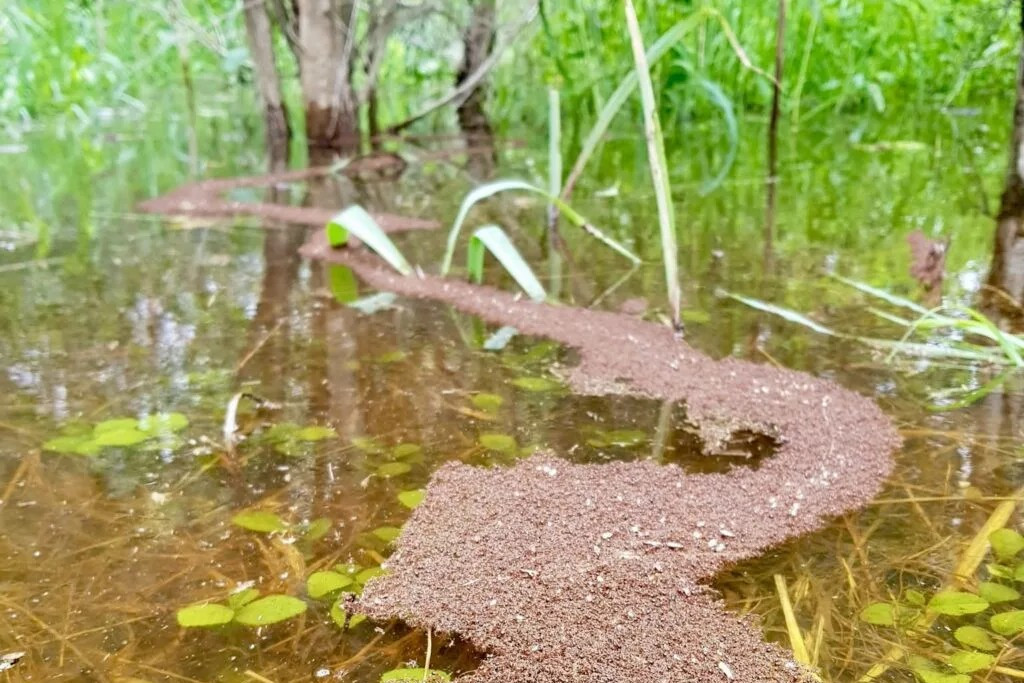News
19 March, 2025
Fire ants hitch a ride
TROPICAL Cyclone Alfred has made fire ant eradication more difficult, with an increase in fire ant activity and visible nests being reported in current areas of infestation, which include Lowood, Glamorgan Vale, Fernvale, Caboolture, Morayfield, Burpengary, Burpengary East, Narangba, and Elimbah.

The floods caused by the cyclone have led fire ants to raft together to survive on slow-moving water. However, if the water moves too fast or the colony remains submerged for too long, the ants die.
According to a spokesperson from the National Fire Ant Eradication Program (NFAEP), despite rafting being observed in Southeast Queensland, “it is not a major cause for fire ant spread outside of currently infested areas,” as most waterways flow into the current infestation area rather than out of it. “Our dedicated call centre has recorded a significant increase in suspect ant reports since ex-Tropical Cyclone Alfred, and we thank Queenslanders for their vigilance in helping to protect our communities,” the spokesperson said.
“After rainfall, fire ants often build their nests higher, making them more visible and easier to spot. Now is the perfect time to look for and report fire ants.”
“Fire ants are aggressive and swarm when disturbed, making them easy to spot.”
While residents continue cleaning up their homes and communities following the cyclone’s impacts, they are reminded to be vigilant for fire ants, which may have been disturbed by the flooding. Fire ants can sting, and their venom may cause severe allergic reactions.
Some areas to check for nests while clearing debris include near footpaths, driveways, garden beds, under timber, rocks, and pavers, and near utility pits or electrical infrastructure. Fire ant nests can appear as mounds or flat patches of loose soil with no clear entry or exit holes.
“Be mindful that fire ants may be hiding in soil, potted plants, branches, or other materials, or in floodwaters,” they said. “Where possible, check items before relocating them. By staying vigilant, reporting fire ants promptly, and being mindful when moving materials, we can protect our homes, communities, and environment.”
Fire ants are copper brown in colour with a darker abdomen, measure 2–6 mm in size, and vary in sizes within one nest. Fire ants are highly adaptive and can survive in a range of climates and conditions, including travelling over and under ground, flying up to 5 km, and rafting.
People also inadvertently help spread them by moving materials such as soil, hay, mulch, manure, quarry products, turf, and potted plants, containers that have been used with organic materials, such as potted plants, and dirty machinery that has been used to move restricted material.
Recently, fire ants have spread further north, with biosecurity zones being put in place for areas of the Sunshine Coast, including Caloundra, Nirimba, and Eumundi.
To eradicate fire ants, the NFAEP must treat 100 percent of properties in the eradication treatment area using aircraft (drones, helicopters, fixed-wing planes), utility terrain vehicles, and handheld spreaders – whether ants are visible or not.
“We apply at least four treatments over two years, followed by five years of surveillance,” the spokesperson said. “The treatment is carried back to the colony by foraging ants, disrupting the queen’s reproduction and leading to eradication. Our eradication treatment consists of small pieces of corn grit soaked in soybean oil containing a low concentration of an insect growth regulator – either pyriproxyfen or s-methoprene.”
The Australian Pesticides and Veterinary Medicines Authority has approved, registered, and/or permitted the products used to treat fire ants, ensuring they are safe for people, animals, and the environment.
More information at fireants.org.au or call 132 ANT (13 22 68).

